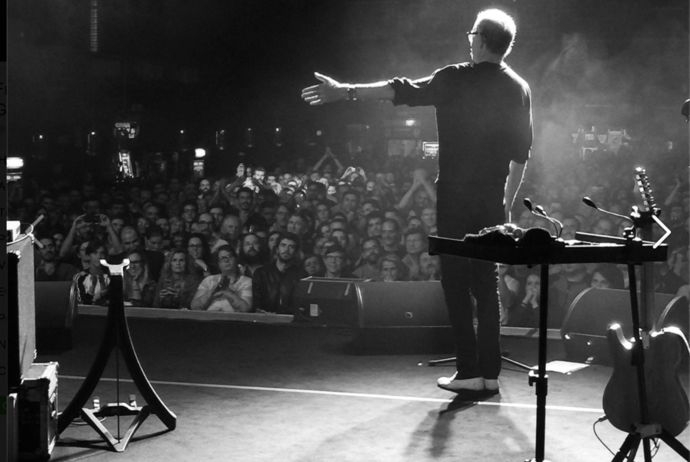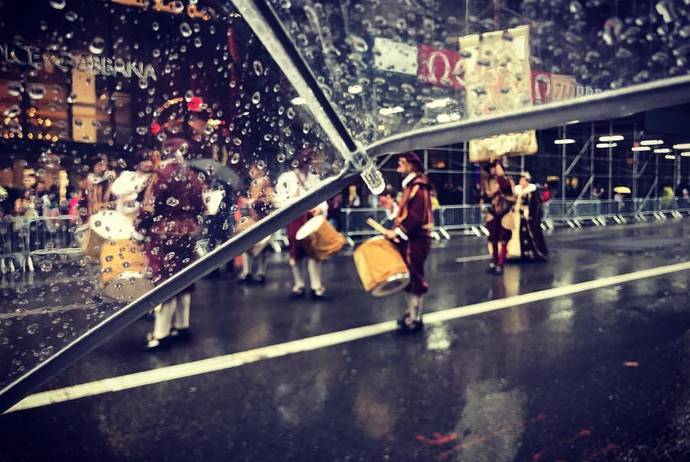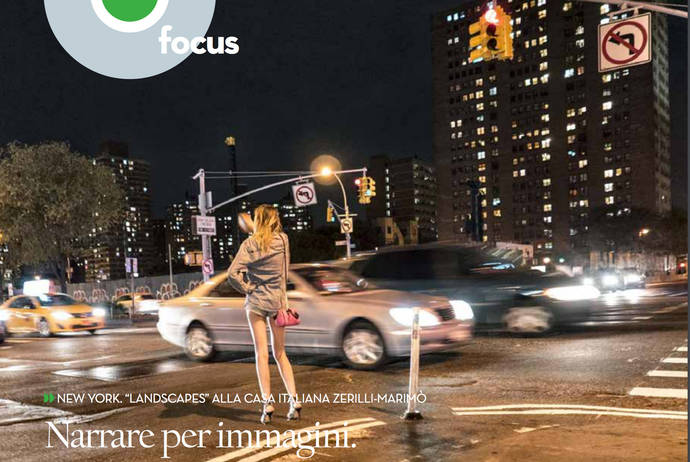ARTICOLO IN ITALIANO >>
Alessandra Salerno is a young Sicilian singer-songwriter who also plays the autoharp when she sings. Once you’ve heard her sound, you won’t forget her, thanks to her voice and the atmosphere that she creates. It’s also hard not be struck by her candor after you’ve spoken to her.
During the course of our conversation, she would describe herself as such:
As a person:
“I’m stubborn, sensible, passionate, courageous, sincere, and often undecided. I also despise injustice. Just one adjective isn’t enough to describe me.”
As a Sicilian:
“I hope I’m able to bring a beautiful image of a young Sicily to the world. A Sicily that does exist, that doesn’t forget its roots, and that wants to share them with the rest of the world. I like it when people say my region is the most beautiful place in the world. I don’t like it when they say that its the most forsaken place in the world!”
As a musician:
“As an artist, I’m an incurable dreamer. Someone like me, who tries to produce something original, has trouble establishing themselves in Italy. Perhaps this is because we’re living in the worst period ever for the music industry. Everything on the radio has the same sound but by different singers.”
We interviewed Alessandra with the intent to introduce her to the American public, who will see her sing at the National Italian American Foundation (NIAF) Gala in Washington DC on November 5th. She will also be appearing at NYU’s Casa Italiana Zerilli-Marimò on November 27.
Alessandra’s music made the judges on The Voice of Italy all turn their chairs in amazement, and she’s still popular two years later. She may not have come in first, but many people still consider her the spiritual winner. It has been a long road since then, but Alessandra traveled it while always remaining grounded in reality.
This all despite the fact that she describes herself as a dreamer. She may be a dreamer, but her feet are always firmly planted on the ground
Let’s start from the beginning.
“I believe music found me when I was still in the womb. As soon as I was born, I wanted to speak and dance. Many people attributed my vivaciousness to the color of my hair, which is naturally red (and being a redhead born in Palermo, I was immediately exposed to popular supersitions).”
No Musicians in the Family.
“I’ve always had a ‘passionate’ temperament. In a simple family of non-musicians, this little red-headed 4-year-old fell in love Pavarotti, Lucio Dalla… Many children from the 80s-90s were traumatized by the ‘monster’ from Rai 1’s LUNEDì CINEMA theme song. I, on the other hand, was able to go to bed. It was everything I was waiting for. I continued to dream that “du bu di, du du rubu bah” by Lucio Dalla with the dove flying in a dark background full of glitter. I used to love the Pink Panther soundtrack more than the Pink Panther himself, and the Tabù candy theme song–along with the little guy dressed in black–more than the candy itself, seeing as I hate liquorice."
She continued speaking about what she felt as a young girl:
“A taste for the beautiful Italian music of the past and passion for jazz, blues, and African-American music continued to develop naturally inside of me. Many years later, I discovered that these musicians that I loved had names. It was music herself who found me.”
What was your first time on the stage?
“It was when I was 8 years old at the teatro Biondo in Palermo. It was 1995, the 100th anniversary of cinema, and I was a soloist in my elementary school’s chorus. I sang original pieces and songs by the great Rosa Balistreri."
Sicily is your cradle, as you describe it. Look how far that girl, who was singing in dialect, has come. From there you went towards the continente (continent), the name Sicilians have for the Italian peninsula. Among your stops was Milan.
“Sicily is a very rich land in terms of music and culture. It’s a transitory land where cultures mix, so it’s easy to find excellencies among the singer-songwriters, jazz, folk, blues, classical music, electronic music, and music of any genre. There’s excitement in air. Sicily represents my ‘beautiful cursed cradle.’
It’s the cradle of art and culture, and there needs to be more investment in regards to these. Sicily current does not have the structures and channels for investing. This is why I spent long periods of time in Milan. It’s the most European city out of them all.
I needed other things to stimulate me, to consult with labels, writers, and go to concerts that would never come to Sicily. I needed to broaden my horizons. In Sicilian we say ‘cu nesci, arrinesci.’ In Italian that would be ‘chi esce, riesce!’ or in English ‘Those who leave, succeed!' Milan has a special place in my heart, and it’s almost a second home for me, but Sicily will always be number one.”
Is it very difficult for an Italian musician like you to establish yourself? Why is that, and what troubles are there?
“A musician like me, who tries to produce something original, has difficulty establishing himself/herself in Italy, perhaps because we’re in a period where everything on the radio has the same sound but by different singers.
Several years ago in the thesis I wrote for my degree in Fashion Design. I spoke about the extreme need to care about niches, the value of individuality, and of ‘emotional marketing.’ Music still isn’t doing this. If I had wrote that thesis today, I would have had to write an entire chapter on the music of today and on the conforming trends that this type of music provokes.”
You’ve participated in talent shows. What’s your opinion on them?
“It’s extremely satisfying to be considered the spiritual winner of The Voice of Italy 2015 and to be remembered for what I did on TV two years ago. This is a real victory because talent shows can be dark forests. You need to make sure you don’t get used. You need to use these shows as showcases for our really fragile careers (and today it seems like these are the only channels you pass through) to reach the most people possible with your music.”
What did you do after The Voice?
“In these past two years I only did things that I like. I continued writing, touring, having new experiences, and growing important collaborations. My music came to Europe and my videos to Latin America. My voice returned to TV in Italy as the soundtrack to a TV series on channel 5, but there’s still a lot to be done. My most important objective is the release of my new disc, and I’m also going to be working on it in New York.”
Tell us about your music.
“I believe my music is the perfect fusion of what has been a part of me since I was little. There’s a bit of America and a bit of beautiful Italy. In my lyrics and in my songs the common denominator is love, an intense love, in a broad sense. Love for life, love for oneself. Sometimes these are stories told through music, and they can hold some of the deepest messages.
My daily life is my inspiration. Good feelings and bad feelings are all part of the human experience, and when I write lyrics, I realize that the song could actually be about anyone. My suffering and desire for freedom, which I often feel as a Sicilian, lead me to grab a pen and an instrument in order to translate what’s in my head and my heart into music.”
Tell us about your decision to play this usual instrument.
“The instrument I play is an autoharp. It’s not common, but it’s an instrument that is both delicate and strong at the same time–just like me… I believe that deciding to buy it and learn how to play it was one of the best things I’ve done in my life. It has become an extension of me…
It was the Carter family’s preferred instrument. I found it years ago after having seen videos from the 50s and 60s and after falling in love with June Carter and Johnny Cash. My music had been waiting for this. Today I’m also an endorser for the most important American producer of the Autoharp, D’AIGLE.”
Now, for the first time ever in America, Alessandra will slip into her shoes as a musician. She was invited by NIAF to perform young Italian music. She will also play a song in Sicilian. She’s going to be at the most important annual gala, and she’ll be bringing her city, Palermo, with her. It’s the same Palermo that will be next year’s capital of Italian culture.
“America is known as the Land of Opportunity. I’m looking for my land of opportunity, my place in the world. I see it as a chance for growth and rebirth. I hope to be able to start my recording project from there, and I dream of it branching out, as far as possible, across the world. I want my music to reach as many souls as possible.
This is a great life moment–singing and playing at the great NIAF Gala.
I’m both grateful and honored to take that place on the stage, which in the past had belonged to great world-renowned Italian artists, at such an important event.
I will finally get to meet the Italian-American organization that has made history in the USA and that continues to be committed to the promotion of the Italian culture across the world. Furthermore, NIAF is sponsoring my first entry into the United States, and I hope it’s a fruitful trip. We’re also only a few months out from the year in which my hometown of Palermo is going to the the Capital of Italian Culture, and I’m also excited for what will happen with that.”
What do you love about American music?
“I love almost everything about American music. As I said before, I was unknowingly born with American music. I find that at the source of it all, there’s the immediacy, this sincerity, this total self-denial that first render it a pure and perfect form of art, and then a form of entertainment. The greatest performers in history come from the cradle of America, a cradle that I would really like to accept me.”
Has Alessandra Salerno been hiding her American dream?
“My American dream is really ambitious. I’m keeping it to myself for now, out of superstition. I hope to be able to talk about it in a few years, perhaps in an interview, whether or not it comes to fruition.”
Last question. If you don’t already know her music, when you listen to it for the first time, you’ll understand this question. Alessandra, are you aware of the magic you create when you sing and play? It’s almost like a fairytale world...
“No, I only feel the vibrations between me, my music, and the audience. I feel a passage open. I live in another dimension, which is as fairytale-like and magical as you described it. I’m so happy and grateful, and I believe I’m going in the right direction.”
“So she sat on with closed eyes, and half believed herself in Wonderland, though she knew she had but to open them again, and all would change to dull reality.” Her way of proposing music reminds me so much of these words from Lewis Carroll’s Alice in Wonderland. Not because Alessandra isn’t familiar with reality but because, with her music, she is able to transport us into a fantasy world that we’ve lost as adults.







































